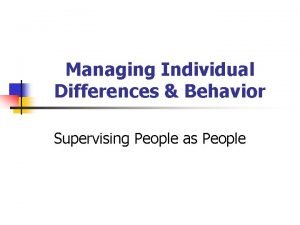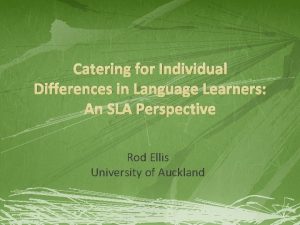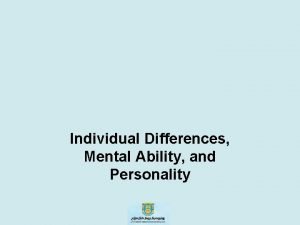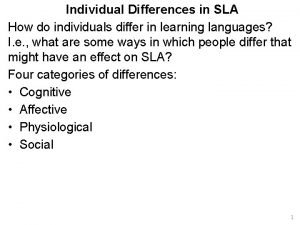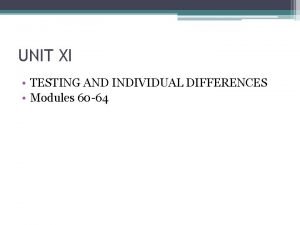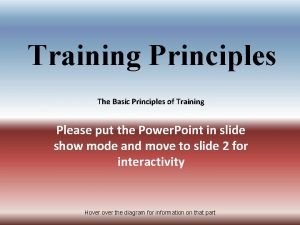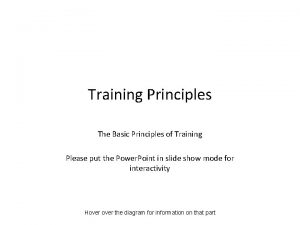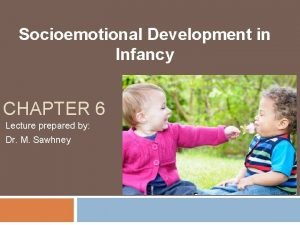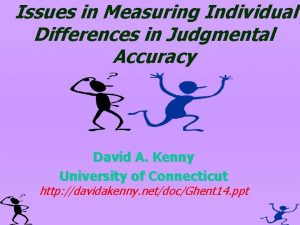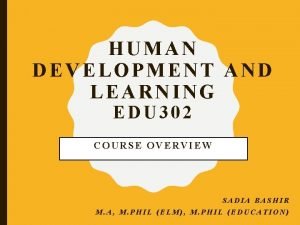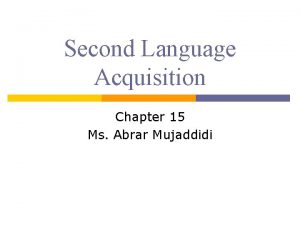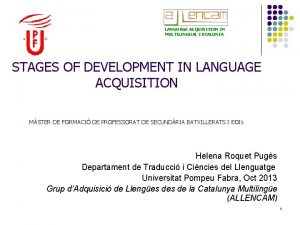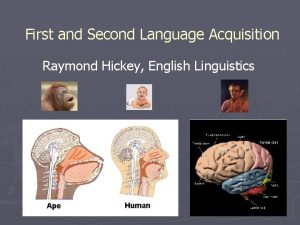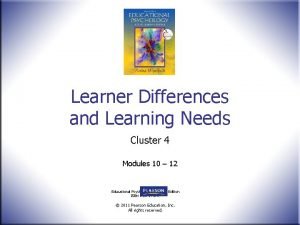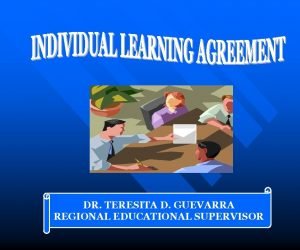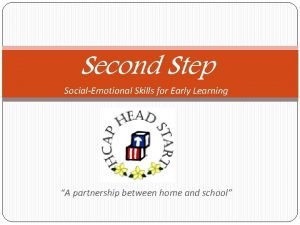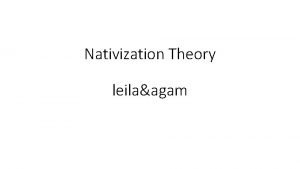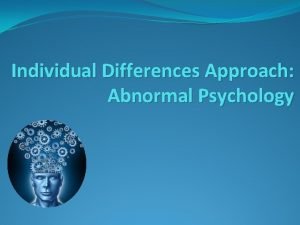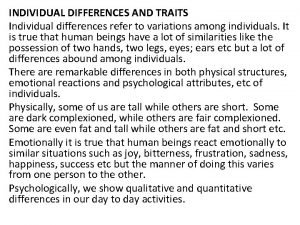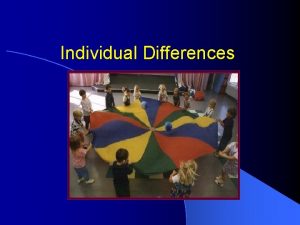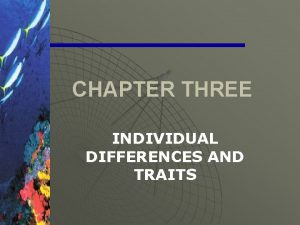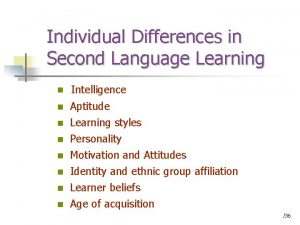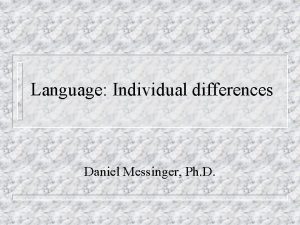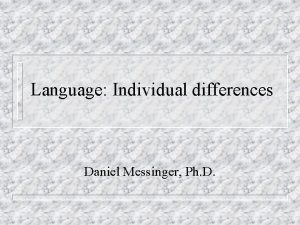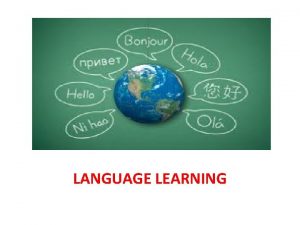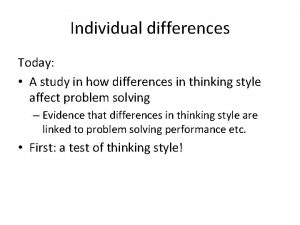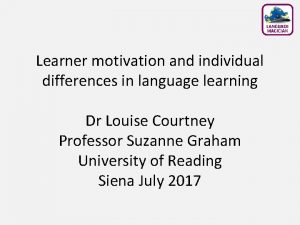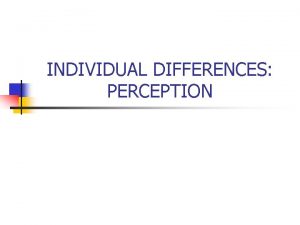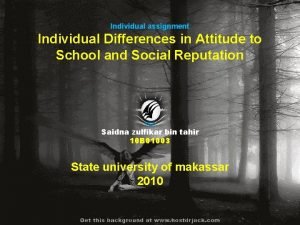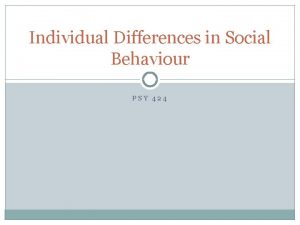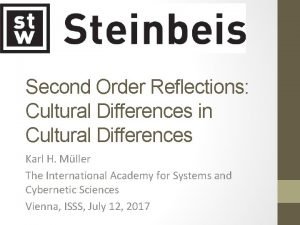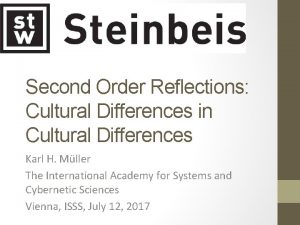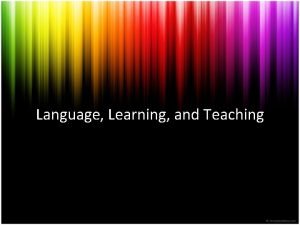Individual Differences in Second Language Learning Dornyei Z


























- Slides: 26

Individual Differences in Second Language Learning Dornyei, Z. and Skehan, P.

Introduction ❏ This text deals with some differences that can be observed within learners that are trying to learn a second language, such as aptitude, learning strategies, and motivation. ❏ Learners of EFL/ESL present certain characteristics that differentiate one from another when learning a language. ❏ It is through linguistic research that these peculiarities are being dealt with, which is why as future teachers, we need to understand the different aspects that may influence a learner’s comprehension of the language.

Foreign Language Aptitude

Foreign Language Aptitude: Talent for learning foreign languages. Questions related: Is it innate? Is it fixed? Is it related to other abilities? Does aptitude predict success? Can it be measured? J. B. Carroll: Psychologist, who developed the four component model of aptitude.

Foreign Language Aptitude Post-Carroll research: Aptitude was regarded as anti-egalitarian, and the normalization of the material used in classes (such as textbooks) made aptitude a useless concept. ▷ Later, aptitude was found out to influence certain scenarios, such as classrooms where ESL and EFL are taught. ▷ Aptitude should not be discarded, as it has been demonstrated that aptitude does play a role within the learning process. Knowing the students’ aptitudes may lead to a more effective teaching process.

Foreign Language Aptitude and SLA

Foreign Language Aptitude and SLA Second language acquisition stages are related to aptitudes which are classified as “Aptitudinal construct” and “Additional aptitudinal construct”.

SLA-Informed Aptitude Research

SLA-Informed Aptitude Research e. Xperanto & Spanish → Two languages that were taught. ▷ ▷ ▷ De. Graaf (1997): Correlation between aptitude test results and learning. Robinson (1995): Correlation between aptitude measures and performance in four conditions; instructed, rule-search, implicit, and incidental. ○ Aptitude plays a role in explicit and implicit learning environments. ○ It appears to be more relevant when there is a focus on form instead of meaning. Further studies determined that aptitude is relevant with certain factors, such as age. Higher levels of aptitude usually lead to higher levels of proficiency in ESL learners past the age of 17 years old.

Cognitive and Learning Style

Cognitive and Learning Style ❏ Cognitive style: Predisposition to process information, in a certain manner. ❏ Learning styles: Preference for approaching learning in general. Field Independence versus Field Dependence FI: Aloof, find solutions by themselves. Analyze the whole to get into the details. Analytic. FD: Sociable and work well in groups. Deal with information as a whole. Hollistic. FI/D: Highly criticized because one was dependent of the other, rather than being based on individuals’ characteristics.

Learning Style Oxford and Anderson state that there could be approximately 20 styles, such as: global vs. analytic - FI vs. FD - feeling vs. thinking - impulsive vs. reflective intuitive vs. concrete-sequential - closure-oriented vs. open extroverted vs. introverted - visual vs. auditory vs. hands-on There are six interrelated aspects in learning styles: Cognitive (Habitual habits of mental working) - Executive (Order, organization) Affective (Values, beliefs, attitudes) - Social (Involvement with others) Physiological (Senses and perception) - Behavioral (Satisfaction)

Kolb model

Language Learning Strategies

Language Learning Strategies ➢ Can be defined as the learner’s active contribution to enhancing the effectiveness of his or her learning. ➢ High language aptitude and motivation are by no means the only learner’s characteristics necessary to a effective learning process ➢ Learner’s active participation in the learning process through individualized learning techniques is crucial.

Language Learning Strategies Oxford ‘s taxonomy O’malley and Chamot‘s taxonomy Cognitive, memory. Cognitive Metacognitive Compensation, affective and social strategies. Social/affective

▷ Cognitive strategies: manipulation of the learning materials/input ▷ Metacognitive strategies: Higher-order strategies aimed at, for example, monitoring one’s own learning process ▷ Social strategies: Interpersonal behaviours ▷ Affective strategies: Taking control of the emotional conditions.

Language Learning Strategies Strategy → Replaced by self-regulation Strategy implied the act of prioritizing thoughts, emotions or behaviour in learning. The term skill is more broad, as it encloses what we can do according to our abilities. Therefore, strategy was disregarded, with skill coming as the ideal term.

Motivation

Motivation It became a widely discussed term in the 90’s. Due to it having strong theoretical background, it was strongly researched, with a great amount of empirically tested propositions. ❏ The Canadian social psychological approach: Attitudes towards L 2 culture affect L 2 learning. ❏ Gardner’s motivation model (1985): ❏ Integrative orientation ❏ Instrumental orientation ❏ Integrative motive (integrativeness, attitudes toward the learning situation and motivation)

Motivation Defining motivation: Why? How long? How hard? Development of “underlying constructs” → key variables that affect motivational components. Expectancy-value theories: ▷ ▷ ▷ Attribution theory: Processing of past achievement experiences. Self-efficacy theory: Self judgement of people’s capabilities. Self-worth theory: Highest human priority is the need for self acceptance and to maintain a positive face. Goal theories: actions are triggered by a sense of purpose, with goals to be achieved. Self-determination theory: Extrinsic vs. Intrinsic motivational paradigm.


Motivation Other lines of research of motivation: ➔ Schumann’s neurobiological research: ◆ First to combine biological elements with motivation. Stimulus appraisal. ➔ Self-determination theory in L 2 motivation ◆ Applying intrinsic/extrinsic elements as organizing points to set goals. ➔ Willingness to communicate (WTC) ◆ “Readiness to enter a discourse at any given time” Context plays a role. ➔ Motivational self-regulation ◆ Learners can be endowed with tools to motivate themselves.

Conclusions ● All the elements that we tried to convey are highly relevant when it comes to language teaching. ● Aptitude is becoming once again more present in learning environments, whereas motivation has been a widely discussed topic, with it being a big part of the conversations and classes we have sustained throughout some of our courses. ● Regarding learning and cognitive styles, it is our duty as teachers to grasp our students capabilities and to work around them, we should try to transmit information in several ways, in order to get across the message to each one of our students.

Questions for discussion ❏ What do you think about the applicability of aptitude tests? ❏ What factors have helped you to learn English and reach your present level? ❏ Do you think that your own motivation has been changing throughout this university programme? If so, why and how?

 Field dependent vs field independent
Field dependent vs field independent Language is
Language is Managing individual differences and behavior
Managing individual differences and behavior Managing individual differences and behavior
Managing individual differences and behavior Catering to individual differences
Catering to individual differences Makalah perbedaan individu dalam organisasi
Makalah perbedaan individu dalam organisasi Pengertian perilaku organisasi
Pengertian perilaku organisasi What are type a people
What are type a people Individual differences in sla
Individual differences in sla Unit xi testing and individual differences
Unit xi testing and individual differences Principle of training variation
Principle of training variation Principles of training individual differences
Principles of training individual differences Thomas and chess temperament
Thomas and chess temperament Conclusion of individual differences
Conclusion of individual differences Growth and development
Growth and development -54
-54 Difference between second language and foreign language
Difference between second language and foreign language Difference of first language and second language
Difference of first language and second language Language
Language Wechsler individual achievement test second edition
Wechsler individual achievement test second edition 27 miles per gallon into kilometers per liter
27 miles per gallon into kilometers per liter Cuadro comparativo entre e-learning b-learning y m-learning
Cuadro comparativo entre e-learning b-learning y m-learning Learner differences and learning needs
Learner differences and learning needs Scienze della formazione
Scienze della formazione Individual learning agreement
Individual learning agreement Second step social emotional skills for early learning
Second step social emotional skills for early learning Nativization theory
Nativization theory


